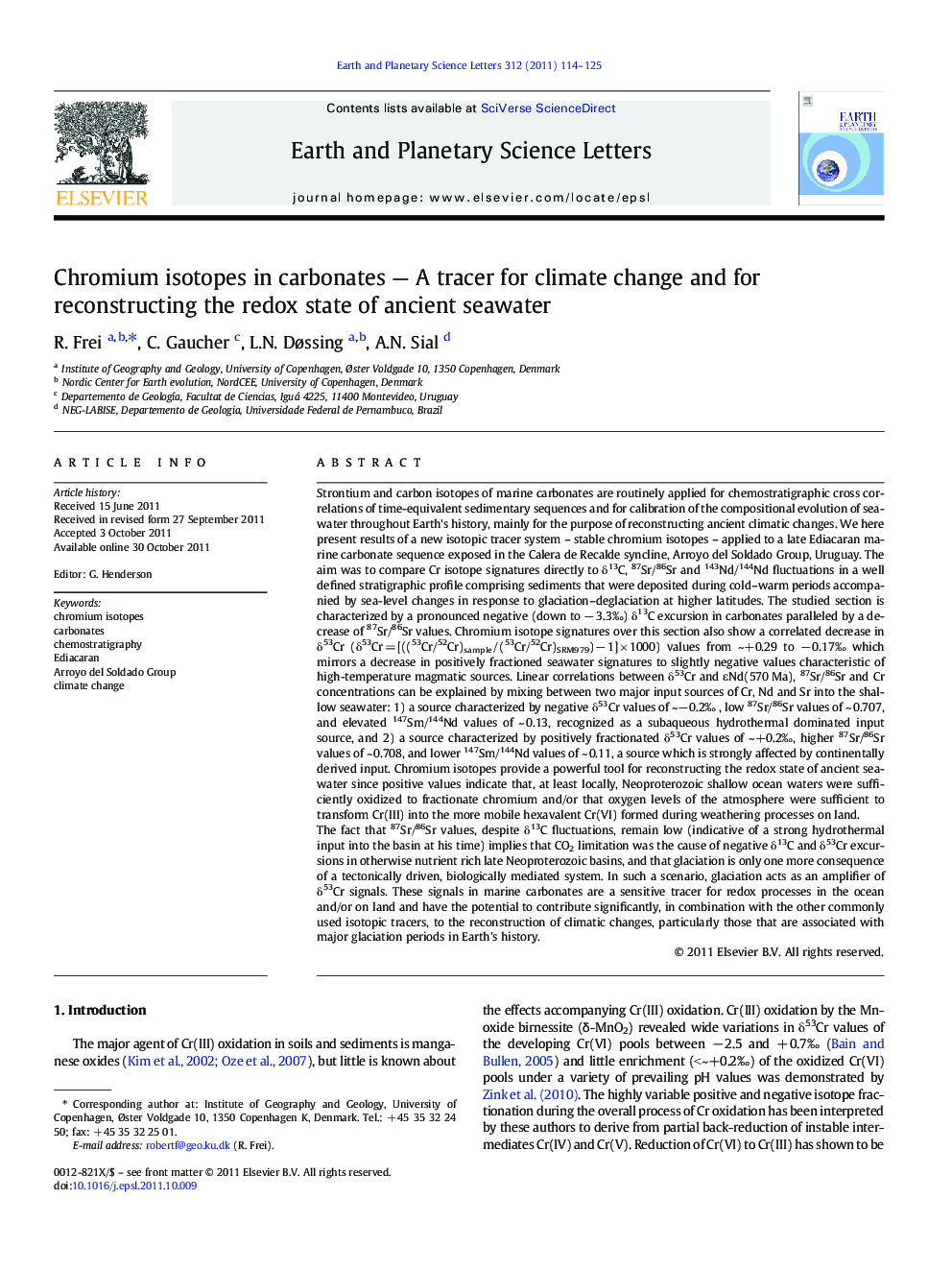| کد مقاله | کد نشریه | سال انتشار | مقاله انگلیسی | نسخه تمام متن |
|---|---|---|---|---|
| 4677781 | 1634816 | 2011 | 12 صفحه PDF | دانلود رایگان |

Strontium and carbon isotopes of marine carbonates are routinely applied for chemostratigraphic cross correlations of time-equivalent sedimentary sequences and for calibration of the compositional evolution of seawater throughout Earth's history, mainly for the purpose of reconstructing ancient climatic changes. We here present results of a new isotopic tracer system – stable chromium isotopes – applied to a late Ediacaran marine carbonate sequence exposed in the Calera de Recalde syncline, Arroyo del Soldado Group, Uruguay. The aim was to compare Cr isotope signatures directly to δ13C, 87Sr/86Sr and 143Nd/144Nd fluctuations in a well defined stratigraphic profile comprising sediments that were deposited during cold–warm periods accompanied by sea-level changes in response to glaciation–deglaciation at higher latitudes. The studied section is characterized by a pronounced negative (down to − 3.3‰) δ13C excursion in carbonates paralleled by a decrease of 87Sr/86Sr values. Chromium isotope signatures over this section also show a correlated decrease in δ53Cr (δ53Cr = [((53Cr/52Cr)sample / (53Cr/52Cr)SRM979) − 1] × 1000) values from ~+0.29 to − 0.17‰ which mirrors a decrease in positively fractioned seawater signatures to slightly negative values characteristic of high-temperature magmatic sources. Linear correlations between δ53Cr and εNd(570 Ma), 87Sr/86Sr and Cr concentrations can be explained by mixing between two major input sources of Cr, Nd and Sr into the shallow seawater: 1) a source characterized by negative δ53Cr values of ~−0.2‰ , low 87Sr/86Sr values of ~ 0.707, and elevated 147Sm/144Nd values of ~ 0.13, recognized as a subaqueous hydrothermal dominated input source, and 2) a source characterized by positively fractionated δ53Cr values of ~+0.2‰, higher 87Sr/86Sr values of ~ 0.708, and lower 147Sm/144Nd values of ~ 0.11, a source which is strongly affected by continentally derived input. Chromium isotopes provide a powerful tool for reconstructing the redox state of ancient seawater since positive values indicate that, at least locally, Neoproterozoic shallow ocean waters were sufficiently oxidized to fractionate chromium and/or that oxygen levels of the atmosphere were sufficient to transform Cr(III) into the more mobile hexavalent Cr(VI) formed during weathering processes on land.The fact that 87Sr/86Sr values, despite δ13C fluctuations, remain low (indicative of a strong hydrothermal input into the basin at his time) implies that CO2 limitation was the cause of negative δ13C and δ53Cr excursions in otherwise nutrient rich late Neoproterozoic basins, and that glaciation is only one more consequence of a tectonically driven, biologically mediated system. In such a scenario, glaciation acts as an amplifier of δ53Cr signals. These signals in marine carbonates are a sensitive tracer for redox processes in the ocean and/or on land and have the potential to contribute significantly, in combination with the other commonly used isotopic tracers, to the reconstruction of climatic changes, particularly those that are associated with major glaciation periods in Earth's history.
► Systematic Cr isotope record over a Late Ediacaran negative δ13C excursion.
► Covariations between Sr, Nd and Cr isotopes imply a two source mixing.
► Mirroring of the δ13C excursion by δ53Cr reflects changes in bioproductivity.
► Cr isotopes in marine carbonates potentially monitor atmospheric fluctuations.
Journal: Earth and Planetary Science Letters - Volume 312, Issues 1–2, 1 December 2011, Pages 114–125